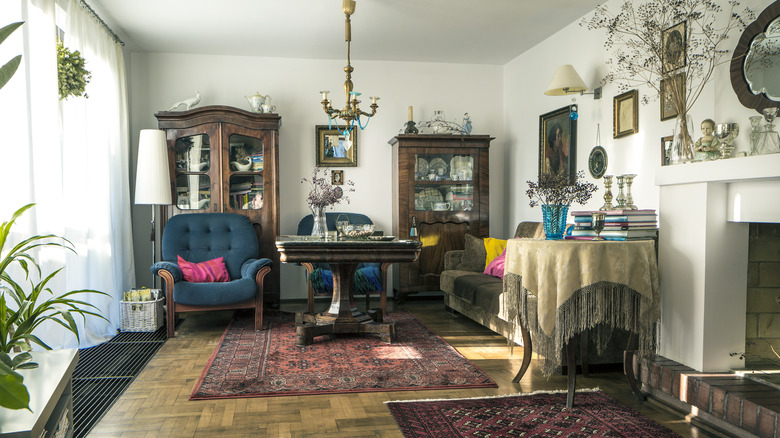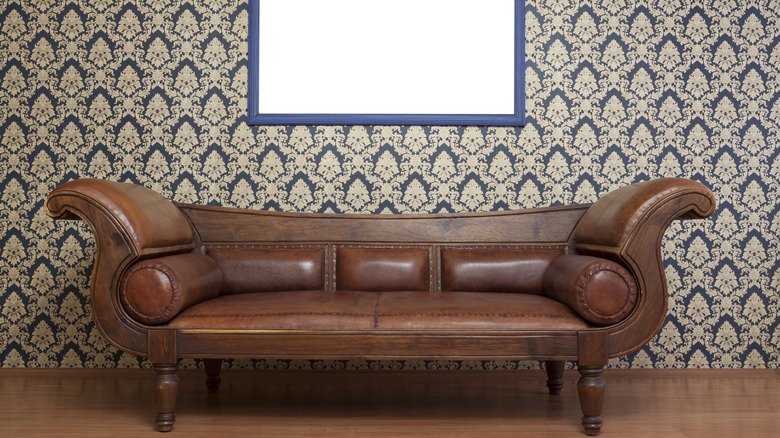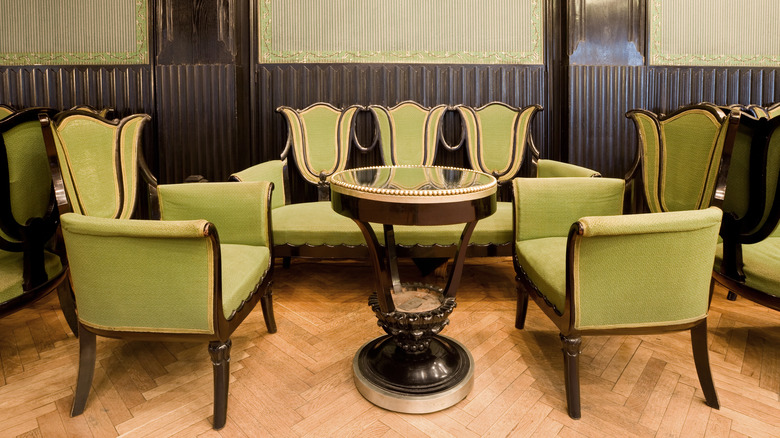The Designer Names You Should Know When Buying Antique Living Room Furniture
According to Rob Wolfe of "American Pickers" fame, the 2020s and the COVID-19 pandemic have brought a major uptick in the popularity of antiques (via Antiques & Auction News). Perhaps the collective time spent isolated in our living rooms has opened our eyes to a need for a little more vintage charm and character in those spaces. For those new to antiquing, separating the true treasures from the furniture items that are simply old can be rather challenging.
Technically, an antique is defined as being at least 100 years old. To start, you can keep an eye out for pieces from the 1920s and earlier (or embrace vintage furniture alongside antiques). Beyond being choosy about time periods, the easiest way to know that you're choosing antique living room furniture pieces that are good investments is to look for established and respected designers of the time. Pieces made by icons like Jacques Adnet and Maison Jansen will never steer you wrong. Consider this your guide to the designer names you should know when buying antique living room furniture.
The Art Deco era and its notable designers (1919-1939)
The most recent furniture design era to hit the antique milestone mark is the Art Deco era. This exciting time in design was all about embracing modern life, manmade materials, and machinery. Art Deco décor and furniture pieces tend to bring about adjectives like sleek, glossy, modern, and streamlined. They often featured simple, symmetrical geometric shapes and materials like glass, plastic, reinforced concrete, and natural materials like wood or stone.
Notable living room furniture designers of the time include Jacques Adnet, Jacques Ruhlmann, Maurice Dufrène, and Süe Et Mare. While shopping for antiques in person allows you to touch, smell, and closely inspect your potential purchases, many online antique resale platforms — such as Chairish — allow you to utilize sort or search functions to discover pieces by the specific designer you're looking for. Don't be afraid, however, to pay attention to the furniture or décor items that you're genuinely drawn to and then do your own research on the designer who created them. You may just discover a lesser-known gem.
Iconic designers of Art Deco's predecessor: Art Nouveau (1880-1914)
Art Deco might be considered the more well-known and popular design era, but the movement's predecessor, Art Nouveau, walked so that Art Deco could run. While it can be thanked for the emergence of a more modern, less historical style, Art Nouveau décor pieces still have a much softer, feminine, more romantic, and whimsical feel than Art Deco furniture. They typically feature some type of organic linear pattern, often taking the form of floral vines and tendrils.
If you're searching for valuable treasures created by truly iconic Art Nouveau designers, keep your eye out for furniture pieces by Josef Hoffman, Louis Majorelle, Henry van de Velde, and Victor Horta. Keep in mind, however, that older antiques are rarer than newer ones, and therefore, designer pieces from the Art Nouveau era that are in good condition are likely to come at a higher price than designer Art Deco pieces in the same condition. The most important factor, of course, is choosing antique pieces for your living room that offer comfort and contentment and fit in with your personal interior style.


